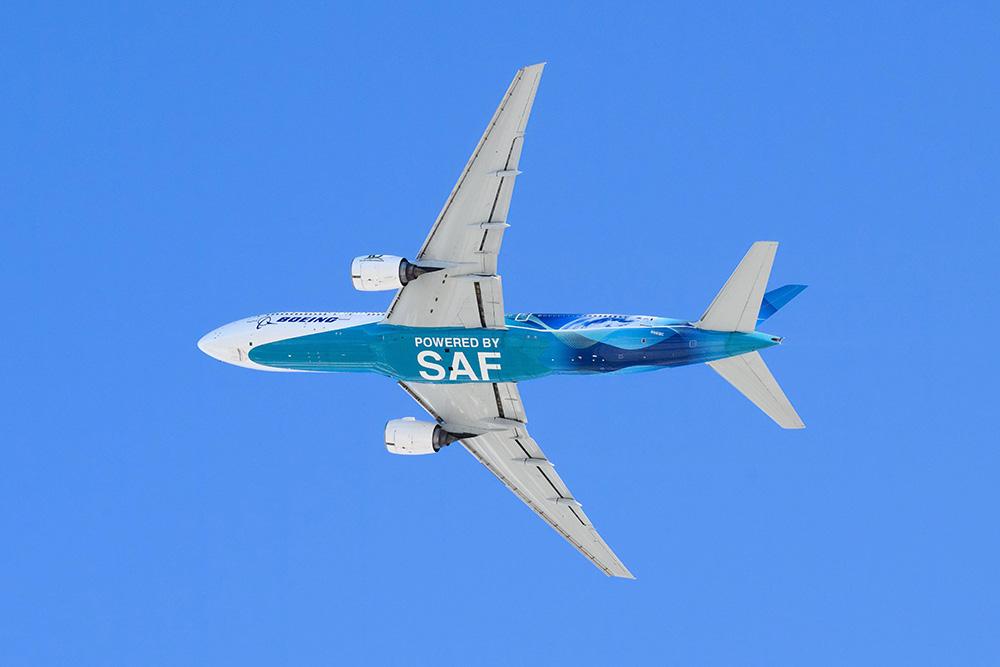
LONDON—Demand for sustainable aviation fuels is expected to outstrip supply over a long-term period as lessors and financiers contemplate both the potential investment opportunities and cost challenges resulting from future sustainability initiatives.
Development of sustainable aviation fuel (SAF) production is moving along to some extent, albeit at a pace that some in the industry see as pedestrian, with some citing a lack of feedstock. Speaking at Aviation Week’s Engine Leasing, Trading and Finance conference in London last week, Nikhil Sachdeva, principal and global lead for sustainable aviation at consultancy firm Roland Berger, did not single out any one factor holding up SAF's progress in a burgeoning market, but says several dynamics are working in tandem to slow its rollout.
“We need the demand to move in a certain way and we need the supply [of SAF] to show up,” he said. Sachdeva predicts certain types of demand will formulate. “There will be mandated demand, which is really starting next year for the first time properly with the 2025 SAF mandate,” he said. “Then there's voluntary demand, which goes above and beyond. Then there's demand which can be monetized as well through airlines selling SAF.”
Sachdeva said that unlike other established fuel sources—such as crude oil, which has had varying forms for around 150 years, and kerosene, which was built to its current usage over several decades—SAF does not have the luxury of being afforded decades to become established, given it is comprised of dozens of different types of feedstock supplied through several production pathways. “We really need to be there now as we have a massive market that needs to be served,” he said.
Relating to the leasing segment, Sachdeva said lessors and the finance community at large are starting to realize that for maybe the next 20 years, demand for SAF will outstrip supply. “It's usually a pretty good position for pricing,” Sachdeva said of their market position. “Investors are starting to realize that there's an opportunity here.”
Lessors are categorized as scope 3 emissions entities, classed as contributing to emissions as a result result of activities from assets not owned or controlled by an organization, albeit still indirectly impacting the aviation ecosystem. In comparison, as operators of aircraft under their control, airlines are in the scope 1 emissions category. In the leasing community, uncertainty exists around what ultimately will happen to both lessors and financiers if targets are not reached in the set time-frames, with the long-term reach being net zero emissions goals by 2050.
“Nonetheless, it's equally important that we [lessors and financiers] have to report on it,” said Conor Murphy, head of portfolio management for the EMEA region at Japan headquartered MUFG Bank. “Like airlines, we must show our finance portfolio year-on-year and the intensity measure of the emissions for our financed aircraft is reducing on the trajectory.”
Murphy said that while the industry is working toward overall net zero 2050 emissions goals and there are some closer-term targets set for 2030, this does not capture “the absolute emissions”—the total amount of greenhouse gases emitted into the atmosphere over a specific time period. “While our intensity is decreasing for every kilometer flown per passenger, as we add new aircraft, and as the overall fleet increases and subsequently overall flying time increases, our absolute emissions for the industry may actually go up while the intensity is potentially coming downwards,” he said.
Ultimately, Murphy believes these trends could potentially expose companies to additional costs while possibly both disincentivizing certain measures and incentivizing other ones. He cites the European Union’s Emissions Trading Scheme and the scenario of the phasing out of emissions allowances, which give carriers the right to emit an agreed upon volume of greenhouse gases. “The emissions that airlines are producing into the EU ... there will be a cost to those going forward and that cost will increase year-on-year,” he said.
Murphy identified SAF as a means of helping to reduce some of these challenges, but its lack of availability to a sufficient level would likely still lead to costs being borne. “The question is, then, do those costs get passed on down the line to the customer? There are so many different variables, and while it’s hard to predict certain events, SAF is such a big component of our planning to get to net zero or interim pathways," heh said. "If SAF is behind projected levels then other costs and penalties will probably kick in, so whatever way you look at it, there will be other increased costs and requirements for airlines, lessors and banks, but it's hard to assess to what extent.”
The impact of sustainability targets is expected to be felt less on asset values by the leasing community and their engine portfolios. “We haven't had to invest capital into retrofitting or changing any technology within aircraft or the engines,” said Gary Leung, vice president of product support at Amsterdam-based SMBC Aero Engines Lease. “If for whatever reason SAF is here tomorrow, these engines can still continue operating and trading as they were, as we're not having to invest any extra capital into the metal itself.”
Leung said one defined impact would be the likelihood of seeing some pressure from shareholders over the type of assets the lessor acquires as they look to improve their portfolios. “Our shareholders will exit assets to accelerate the sales of those older assets and bring newer ones into the portfolio so that the carbon intensity we are reporting continues to decline,” he said.





